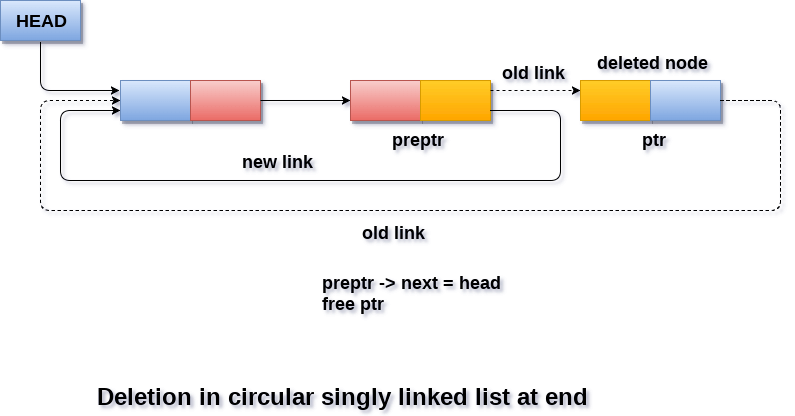TheDeveloperBlog.com
C-Sharp | Java | Python | Swift | GO | WPF | Ruby | Scala | F# | JavaScript | SQL | PHP | Angular | HTML
Deletion in Circular Singly Linked List at End
Deletion in Circular Singly Linked List at End with Introduction, Asymptotic Analysis, Array, Pointer, Structure, Singly Linked List, Doubly Linked List, Circular Linked List, Binary Search, Linear Search, Sorting, Bucket Sort, Comb Sort, Shell Sort, Heap Sort, Merge Sort, Selection Sort, Counting Sort, Stack, Qene, Circular Quene, Graph, Tree, B Tree, B+ Tree, Avl Tree etc.
Deletion in Circular singly linked list at the endThere are three scenarios of deleting a node in circular singly linked list at the end. Scenario 1 (the list is empty)If the list is empty then the condition head == NULL will become true, in this case, we just need to print underflow on the screen and make exit.
if(head == NULL)
{
printf("\nUNDERFLOW");
return;
}
Scenario 2(the list contains single element)If the list contains single node then, the condition head → next == head will become true. In this case, we need to delete the entire list and make the head pointer free. This will be done by using the following statements.
if(head->next == head)
{
head = NULL;
free(head);
}
Scenario 3(the list contains more than one element)If the list contains more than one element, then in order to delete the last element, we need to reach the last node. We also need to keep track of the second last node of the list. For this purpose, the two pointers ptr and preptr are defined. The following sequence of code is used for this purpose.
ptr = head;
while(ptr ->next != head)
{
preptr=ptr;
ptr = ptr->next;
}
now, we need to make just one more pointer adjustment. We need to make the next pointer of preptr point to the next of ptr (i.e. head) and then make pointer ptr free. preptr->next = ptr -> next; free(ptr); Algorithm
Write UNDERFLOW [END OF LOOP] 
C Function
#include<stdio.h>
#include<stdlib.h>
void create(int);
void last_delete();
struct node
{
int data;
struct node *next;
};
struct node *head;
void main ()
{
int choice,item;
do
{
printf("1.Append List\n2.Delete Node from end\n3.Exit\n4.Enter your choice?");
scanf("%d",&choice);
switch(choice)
{
case 1:
printf("\nEnter the item\n");
scanf("%d",&item);
create(item);
break;
case 2:
last_delete();
break;
case 3:
exit(0);
break;
default:
printf("\nPlease Enter valid choice\n");
}
}while(choice != 3);
}
void create(int item)
{
struct node *ptr = (struct node *)malloc(sizeof(struct node));
struct node *temp;
if(ptr == NULL)
{
printf("\nOVERFLOW\n");
}
else
{
ptr -> data = item;
if(head == NULL)
{
head = ptr;
ptr -> next = head;
}
else
{
temp = head;
while(temp->next != head)
temp = temp->next;
ptr->next = head;
temp -> next = ptr;
head = ptr;
}
printf("\nNode Inserted\n");
}
}
void last_delete()
{
struct node *ptr, *preptr;
if(head==NULL)
{
printf("\nUNDERFLOW\n");
}
else if (head ->next == head)
{
head = NULL;
free(head);
printf("\nNode Deleted\n");
}
else
{
ptr = head;
while(ptr ->next != head)
{
preptr=ptr;
ptr = ptr->next;
}
preptr->next = ptr -> next;
free(ptr);
printf("\nNode Deleted\n");
}
}
Output 1.Append List 2.Delete Node from end 3.Exit 4.Enter your choice?1 Enter the item 90 Node Inserted 1.Append List 2.Delete Node from end 3.Exit 4.Enter your choice?2 Node Deleted
Next TopicDoubly Linked List
|
Related Links:
- Deletion in Doubly Linked List at The End
- Deletion in Doubly Linked List After The Specified Node
- Deletion in Circular Singly Linked List at Beginning
- Deletion in Doubly Linked List at Beginning
- Deletion in Singly Linked List at Beginning
- Deletion in Binary Search Tree
- Deletion in AVL Tree
- Deletion in Circular Singly Linked List at End
- Deletion in Singly Linked List at End
- Deletion in Singly Linked List After Specified Node
- Deletion in Circular Doubly Linked List at Beginning
- Deletion in Circular Doubly Linked List at End

